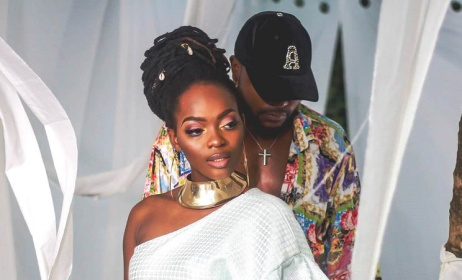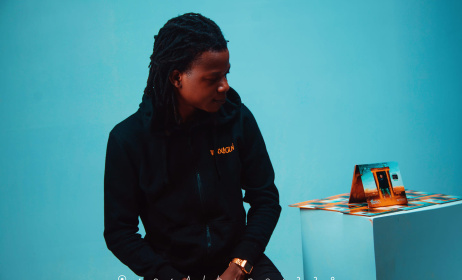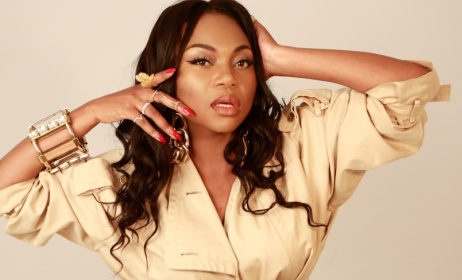Hip hop in Gabon
By Magali Wora Palmira
With a relatively young population composed mostly of people between the ages of 15 and 54, Gabon is a Central African country where hip hop is arguably the most preferred music genre.
 Kôba Building.
Kôba Building.
During the general elections of 2009, renowned hip hop artists such as Hay'oe, Kôba Building, Ba’Ponga, Jojo, Tina and many others chose to campaign for presidential candidate Ali Bongo Ondimba. A campaign song called ‘Paroles Aux Jeunes’ (Youth, Have Your Say) with the chorus “On te suit” (we support you) was written to motivate young people to vote for Ondimba
A number of prominent names of Gabonese urban music performed during several free big concerts across the country. But this wasn’t the first time hip hop and politics converged. During the presidential election of 2005, music label Eben Entertainment initiated a campaign called Bouge Ton Vote (get your vote moving) to encourage younger members of society to go to the polling stations.
The two aforementioned examples point to a pattern where politics employ hip hop to unify young people in Gabon.
The beginning of the hip hop movement
Hip hop was born in New York, more specifically in South Bronx, in the late 1970s. It then spread throughout the US and the rest of the world. Africa was not spared by this revolutionary movement, whose main disciplines are rapping, deejaying, breakdancing, graffiti and beatboxing.
In Gabon, hip hop was introduced by Klaus, whose real name is Gervais Mpouho. Mpouho is the nephew of late president Omar Bongo, who reigned over the country from 1967 until his death in 2009. It is from the XVI Arrondissement in Paris where he resided (arrondissements are Paris’ districts with 16e being a posh district associated with wealthy people), that Klaus, a rap enthusiast, formed Gunthers Family with his brothers and friends in June 1989. The group’s music was inspired by the iconic American hip hop group Public Enemy.
Under V2A4 (Vis Tout et Fort, meaning 'live out loud'), Gunthers Family released the album African Revolution, in which Klaus openly criticises African dictatorial regimes including his native Gabon’s. Hits from this album such as ‘Un Message de V2A4’ or ‘Les Filles’ were released and sold in Gabon and France on vinyl, cassette and maxi-single. As the leader of the collective, Klaus wrote and composed the music.
The year 1990 was defined by political unrest. A national conference was held in Libreville from 23 March to 19 April 1990. The conference was regarded as a major political event in the central African region as well as on the entire continent. The end of a single-party government was agreed on and fundamental democratic rights were awarded to the Gabonese people. This also signalled a transformation of the audio-visual landscape in the country, with numerous private and pirate radio stations as well as home studios being born.
All these events contributed to popularise the hip hop movement that was already boiling in high schools and through rap competitions that took place at the Cabaret des Artistes venue in Libreville.
In 1991, Radio Africa No 1, a pan-African station based in Libreville, promoted Gabonese hip hop through Les Rappeurs de la Côte-Ouest (Rappers From the West Coast), a programme presented by Arcade Mbanangoye. The show played a key role in the emergence of Gabonese hip hop. The genre and its Gabonese progenitors was also covered by programmes such as Hit-Parade Marlboro on Africa No 1, Canal Evasion on RTG1 (now Gabon Télévision) and Bhat Power Show with Régis Massimba on TéléAfrica.
Several groups emerged during the early 1990s with Siya Po'Ossi X standing out among the rest. Siya Po'ossi X, led by Lawana, became well known in 1991 with the release of the album Seyougam whose single ‘L’idiot de la Radio’ (The Idiot of the Radio) denounced the bias of radio presenters. Mapane Groove Act 1 was released in 1997 with corruption and police brutality in its crosshairs. By 1998, when the group released Mapane Groove Act 2, Siya Po'ossi X had confirmed their authority as one of Gabon’s most successful hip hop outfits.
The Golden Age of Gabonese rap
In 1995, the rap collective Buk Drama, which included rappers such as Movaizhaleine, Raboon, Acid Gangsta, Dikam and Poetic Gangster, was formed. A year later they launched the album Le Matcha.
The first major compilation of Gabonese hip hop, Bantu Mix Ess-Pou-Are (read Bantu Mix Espoir), was released in 1997. The compilation was produced at Kag Pro, a recording studio owned by arranger Georges Kamgoua, and included Block PF, Naneth & Eveline, Hay'oe, New Skul, BWV (now B Lani), Professor T, NBK, Encha'a & Duru, Monee, and Verena. Bantu Mix was released on CD and cassette and was followed with a concert called Bantu Live.
In 1998 the album Conscience Noir by rappers Yves Saint l’Amour, Titus and Freddy topped all the charts. Yves Saint l'Amour went solo in 2001 and released the seven-track album Show Gars. Around the same time Professor T became the pioneer of the raggamuffin scene.
In 2000, Secta’a, a new rap group made up of Clan V (V2A4) released the maxi-single ‘Où Les Cœurs Se Glacent’ (Where the Hearts Freeze). An album with the same name followed in 2006. The album's success gave the group an opportunity to perform at big African hip hop festivals like Africarap (Togo), Rap Aussi (Guinea Conakry) and Waga Hip Hop (Burkina Faso).
In the same year, Raabon released ‘Amour Puis Vie de Haine’ (Love Then Hate). The song received extensive radio and TV airplay. The group began appearing on some of the biggest local music stages and won a number of awards. Raaboon later changed their name to Raaboon Phenomenal and included members Tate Kombil, Bibalou Nganga, Frank Ba'Ponga, Love Clara and DJ Zangbeto.
Movaizhaleine, meanwhile, released the classic ‘Aux Choses du Pays’ (The the Things of the Country) in collaboration with Gabonese artists Pierre-Claver Akendengué and Annie-Flore Batchiellilys. In 2007, the group released the album Gestation 3.5, after which the its members, Massassi and Maggeintha, embarked on solo careers.
In 2003, traditional rap emerged as the dominant subgenre in Gabonese hip hop with artists like Communauté Black and Teck B leading the movement. That year was also defined by the launch of influential hip hop label Eben Entertainment, which looked at a number of innovative ways to market its artists such as Ba'Ponga, Kôba Building, Secta'a, Cherokee, Masta Kudi, La Fuenté and Nephtali Original. The label paved the way for commercial rap, which was less politically committed but still touched on social issues. The emergence of the subgenre also marked the beginning of hip hop as a profitable enterprise for labels and artists.
Translated from French by Patricia Yumba Muzinga
Sources
Populations du monde: http://populationsdumonde.com/fiches-pays/gabon
Gaboneco: http://www.gaboneco.com/gabon-musique-le-hip-hop-gabonais-s-engage-dans-...
Gabon Célébrités : https://gaboncelebrites.com/documentaire-gabonais-siya-poossi-x-lhistoir...





























Commentaires
s'identifier or register to post comments